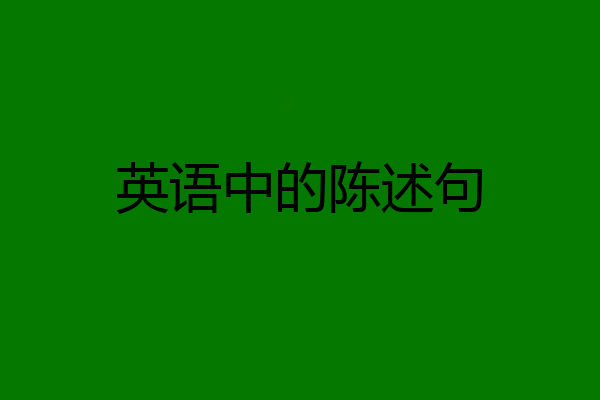
typical2006
英语中的陈述句有:肯定句和否定句。
陈述句用来陈述事实或观点,主干结构是:主语+谓语+宾语(主谓宾)和主语+系动词+表语(主系表)。陈述句可进一步分为肯定句和否定句。
一、肯定句
The river flooded. 河水泛滥了。(主谓)
He has a sense of humor. 他有幽默感。(主谓+宾)
He can teach you English. 他可以教你英语。(主谓+双宾)
He painted the desk blue. 他把书桌涂成了蓝色。(主谓+宾+宾补)
He is a doctor. 他是一名医生。(主系表)
二、否定句(be 动词和情态动词后直接加 not;或者,助动词加 not)
The river did not / didn't flood. 河水没有泛滥。
He does not /doesn't have (has not / hasn't) a sense of humor. 他没有幽默感。
He cannot / can't teach you English. 他不能教你英语。
He didn't paint the desk blue. 他没有把书桌涂成蓝色。
He is not / He's not / He isn't a doctor. 他不是一名医生。
注意:否定句中 some 要改为 any.
He doesn't have any interest in it. 他对此一点兴趣也没有。


小小暖和
1、基本结构:主语+谓语+宾语 或者:主语+系动词+表语
主语+谓语+宾语:主语是名词性的词,谓语是动词或动词短语,宾语是动作的承受者或解释谓语的结果。
She doesn’t like singing.
她不喜欢唱歌。
Mike played basketball yesterday.
迈克昨天打篮球了。
I prefer the one on the right.
我更喜欢右边的那个。
主语+系动词+表语:主语是名词性的词,系动词就是be动词,表语则用来表示主语的状态、样子等等。
I am a teacher.
我是一名教师。
Her voice sounds sweet.
她的声音听起来很甜美。
His hobby is taking photos.
他的爱好是拍照。
2、陈述句有肯定形式和否定形式两种:
1)肯定陈述句
I like singing and dancing.
我喜欢唱歌和跳舞。
2)否定陈述句
She doesn't want to go out.
她不想出去。
3、肯定陈述句改否定陈述句,变换方式主要有两种:
①一般是在be动词或情态动词后加not。
Mary was at home yesterday. —>
Mary was not at home yesterday.
玛丽昨天没在家里。
Tom can sing English songs.—>
Tom can not (can't) sing English songs.
汤姆不会唱英文歌。
②不含be动词或情态动词的,行为动词前要用助动词的否定式(don’t,doesn’t,didn’t),后面跟动词的原形。
He likes drawing pictures.—>
He doesn’t like drawing pictures.
他不喜欢画画。
She went to the park yesterday. —>
She didn’t go to the park yesterday.
她昨天没有去公园。

完善自已
英语的句子可根据两个标准分类,即按其使用目的或按语法结构(即句子的形式)来分类。按其使用目的,句子可分为:陈述句: This is a dog.这是一只狗。疑问句: Is this a dog?这是一只狗吗?祈使句: Open your eyes!睁开眼睛!感叹句: What a beautiful dog this is!这是只多么漂亮的狗!按语法结构,句子可分为:简单句: I am studying.我在读书。并列句: I am studying, but he is playing.我在读书,他却在玩。复合句: Although I am studying, he is playing.虽然我在读书,他却在玩。陈述句凡是说明一件事情,提出一个看法,或是表达种心情的句子都是陈述句。大多数的句子都是陈述句,它可以用肯定式和否定式。句末用句号“?”,通常用降调。We live in Beijing.(肯定句)我们住在北京。We don’t live in Beijing.(否定句)我们不住在北京。因为陈述句是英语中最常用的基本句子,我们在讲述时态时,详细地讲述了各种时态的陈述句。本节侧重于陈述句中的否定结构,现把英语中否定句总结如下:1 be动词、一般动词(实义动词)、情态动词的否定句I am not a student. 我不是学生。I don't know him. 我不认识他。He can't speak English. 他不会说英语。1.be动词的否定句a.句型:主语+be动词+not~.I wasn't good at English.我英语不好。He isn't hungry.他不饿。b.进行时和被动语态(现在时、过去时、进行时)都有be动词,所以它们的否定句与be动词的否定句同形。(详见第十三章被动语态)They aren't cleaning the room.(现在进行时)他们没在打扫房间。The child was not looked after.(过去时的被动语态)这个孩子以前没有被照顾过。c.将来时(will,